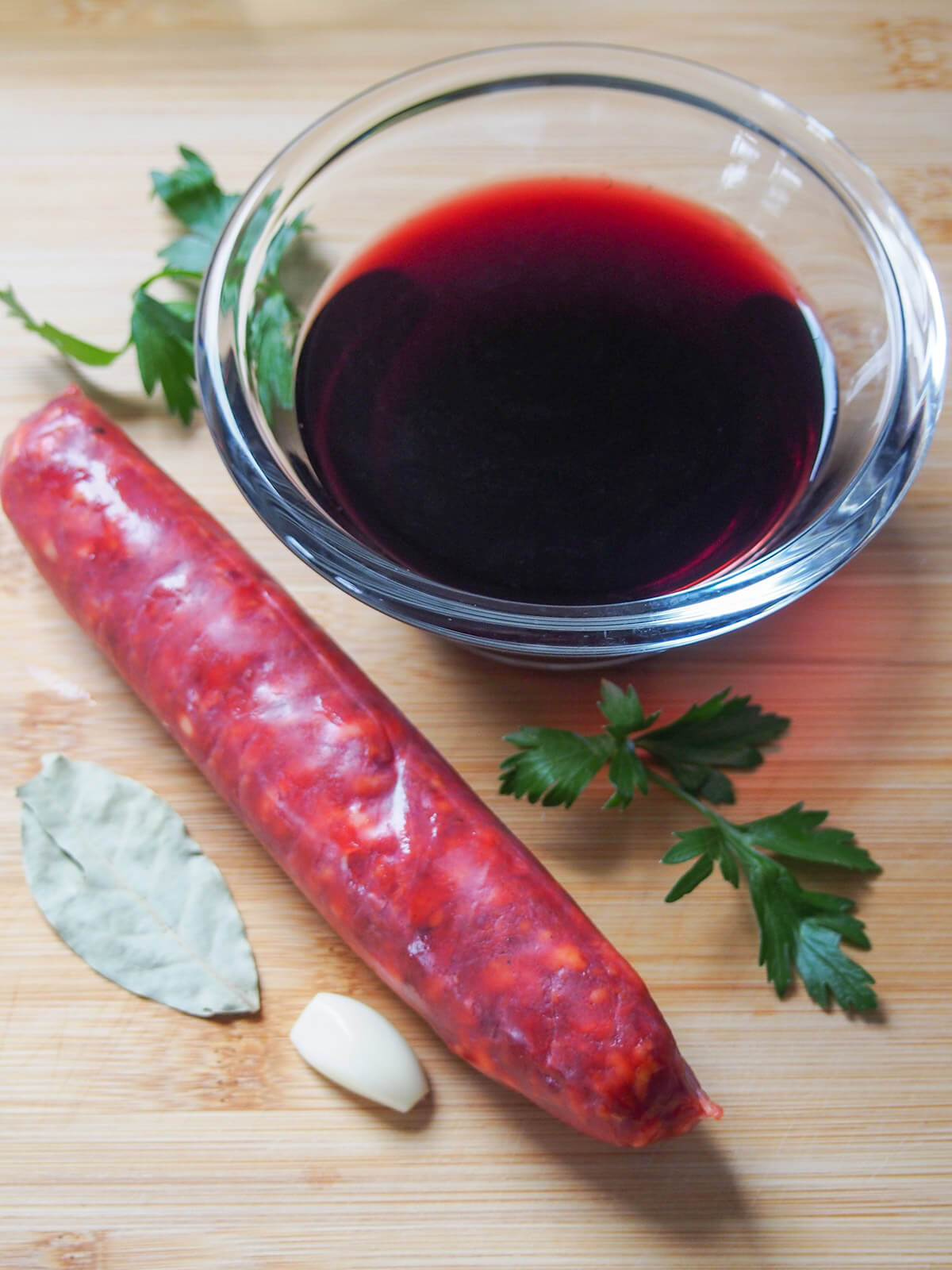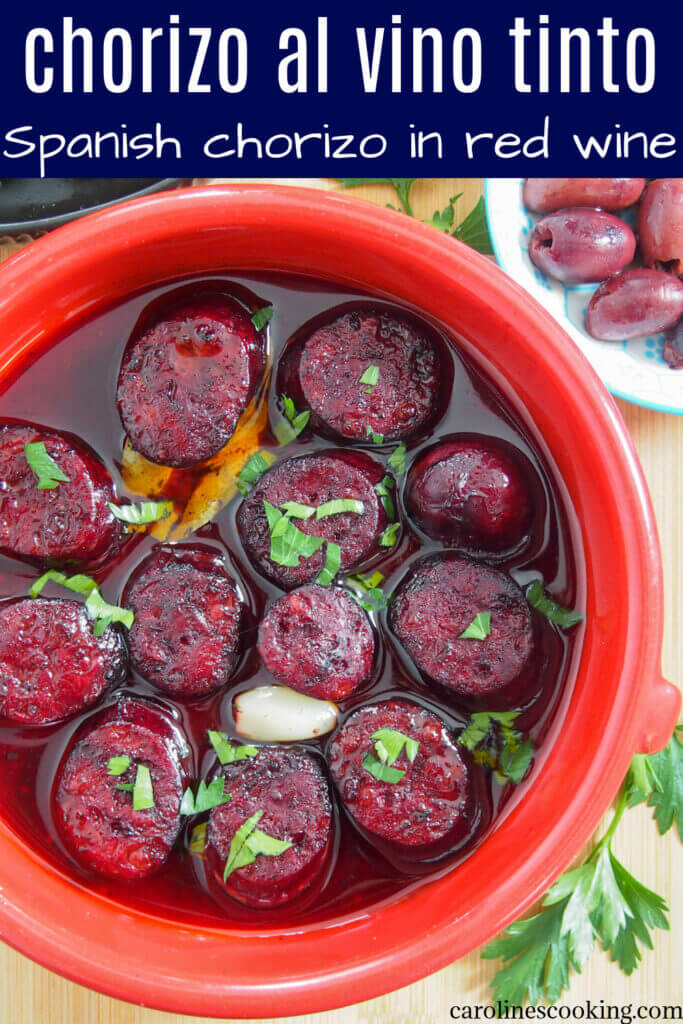Chorizo al vino tinto is a simple Spanish tapas dish where you cook slices of chorizo in red wine giving them a wonderful extra boost of flavor. They're great to nibble on along with other tapas for a light meal or snack.

This post may contain affiliate links, where we earn from qualifying purchases. See more details in the policy page.
Tapas are something that you can put your own twist on, but there are a few classics that you'll see regularly on the menu if you are visiting Spain. Some Spanish tapas you'll find across the country while others are more regional, like salmorejo in Cordoba and pulpo a la feira (octopus) in Galicia.
This chorizo tapas is one you will find all around the country. It's easy to see why since it uses the beloved chorizo, is easy to make and tastes delicious.
In Asturias in particular in the North coast you may see a similar dish, chorizo a la sidra (the local 'hard' cider which is relatively dry) instead or as well. It's made in much the same way but naturally the end flavor is that bit different. Both are definitely worth trying.

Different types of Spanish chorizo
Chorizo is definitely a big favorite of the many Spanish pork products and comes in a few different varieties. Unfortunately, not all of these are available outside Spain. But it's worth being aware of them so you have a sense in what you are looking for.
The first thing to look for is whether it is spicy or mild. Chorizo gets it color and much of the flavor from paprika. Spanish paprika is almost always smoked and comes in either a mild/sweet form or spicy. Chorizo picante is made with the spicy (picante) paprika, while the chorizo dulce is made with the mild form.
Both are delicious and you can, to a point, use them interchangeably depending on whether you want a bit more of a kick in there. Some recipes, though, will state one or the other.
To make things slightly more confusing, some regional varieties use a combination of both sweet and spicy, like chorizo riojano, from the Rioja region. The regional versions may also use slightly different additional flavors in there (the Rioja version uses garlic). Some use different cuts of meat, make them different thicknesses etc impacting the appearance and texture. All the more reason to try different ones, I'd say.
The next thing to look for is the level of cure. The vast majority of Spanish chorizo overseas is fully cured, chorizo curado, as this is the most highly preserved. This kind is dry and can be eaten uncooked. However in Spain and sometimes elsewhere you'll find fresh (chorizo fresco) or semi-cured (semi curado). These last two are softer and need to be cooked before eating.

Finally, if you are looking to just eat it as it is, you might want to treat yourself to an iberico chorizo. Chorizo follows the same grading as Serrano ham with iberico ham the superior version. Belota iberico is the cream of the crop made from one particularly variety of pig that is fed only acorns. Yes, it is more expensive, but it melts in your mouth and has a wonderful flavor.
Cooking chorizo in wine
I know that may be an overdose in information, but hopefully it may help you decipher all the labels. And for this, you are looking for a fresh or semi-cured chorizo intended for cooking. Whether you choose spicy or not is up to you.
You can use fully cured but it tends to become too firm and not absorb the flavor as well. If this is your only option, try not cooking it too much initially.
Once you have your chorizo, all you do is slice it up, cook it to crisp up the outside then add your wine, bay leaf and garlic. Let it all simmer so all the wonderful flavor is absorbed into the chorizo.

How to serve this tapas
One of the great things about tapas is you can mix and match dishes as suits your taste. Bread is particularly good with this, even if just plain, to soak up the tasty reduced wine sauce.
If you are looking to make more of a meal of tapas, I always try to look for a balance in what I choose. Some form of bread or potatoes is pretty much obligatory in Spain. If you're not already having plain bread, then pan con tomate (tomato bread) is a great choice and patatas bravas are a big favorite too.
Since this is a very meaty dish, I would also suggest something lighter alongside such as a vegetable dish like blistered Padron peppers. A Spanish cheese plate and/or some olives would also be good for nibbling on.

Spanish chorizo al vino tinto (in red wine) is such an easy dish to make and packed with flavor. It's perfect to add some authentic flavor to a Spanish meal, or simply to enjoy just because. You only need a few ingredients and a few minutes to make this classic dish, so all the more reason to make and enjoy.
You can find many more Spanish recipes, including more tapas, mains and desserts, in the archives.
Chorizo al vino tinto (chorizo in red wine)
Ingredients
- 3 ½ oz fresh chorizo or semi-curado (see below and more detail above)
- 1 teaspoon olive oil
- ½ cup red wine (eg Rioja/tempranillo)
- 1 bay leaf
- 1 clove garlic peeled but left whole
- 1 teaspoon parsley chopped, approx, to serve
Instructions
- Cut the chorizo into even slices (around ¼in/3mm thick or a little more).
- Warm the oil in a small skillet/frying pan over a medium heat and add the slices of chorizo in a single layer. Cook for around 3-4 minutes until starting to crisp then turn over.
- Cook for a couple minutes on the other side then add the wine to the pan. Tuck the bay leaf and whole, peeled garlic clove in between or under the chorizo slices.
- Once the wine comes to the boil, reduce the heat slightly and simmer for around 15-20 minutes until the wine has reduced by about half and become slightly more syrup-like. Remove from the heat and serve either in the skillet or a terracotta dish, topped with a little chopped parsley.
Video
Notes
Nutrition
See some of my favorite cooking tools and ingredients in the Caroline's Cooking Amazon store.
Remember to pin for later!




Amanda Wren-Grimwood says
This was so delicious. I love the crispy edges of the chorizo and the flavour the wine gives. Great tapas idea.
Caroline's Cooking says
Glad you enjoyed, and yes the wine really does get in and add a lovely flavor.
Ofelia De La Cruz says
Facil y muy bein detallado. Gracias por esta receta:)
Caroline's Cooking says
De nada, y gracias por su comentario.
Allyssa says
Thank you so much for sharing this very easy and delicious recipe! I really loved it and I'm excited to make it again!
Caroline's Cooking says
So glad to hear! Agree it's so easy and tasty.